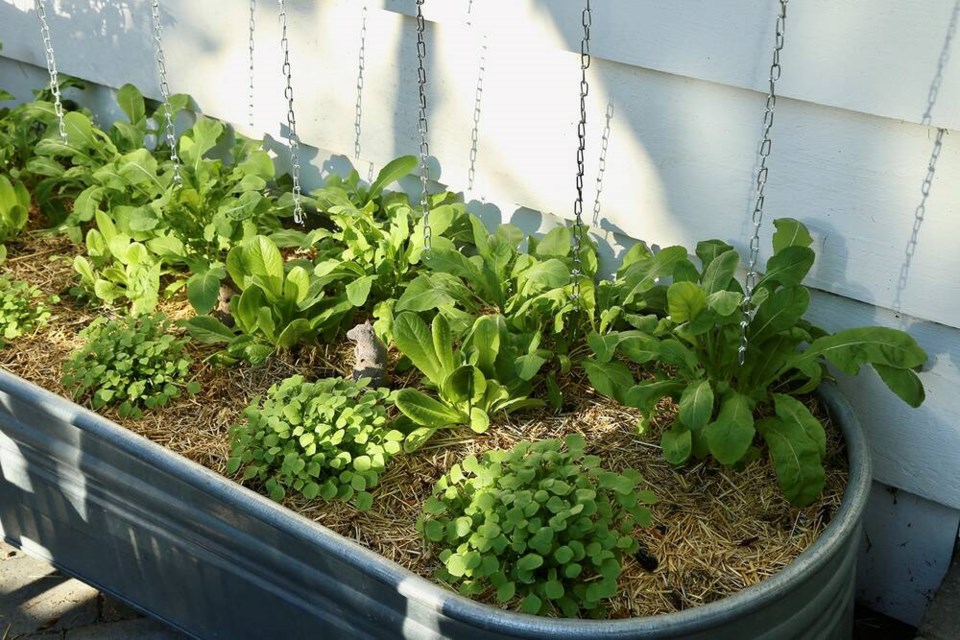This season of gifting and receiving invites reflection, and for me, inspires gratitude.
Our family is uncommonly blessed with many gifts, not the least of which is our garden. There are few essential human virtues, that a garden cannot teach us.
It seems nothing short of miraculous that, in this cold and dark climate, we can grow extraordinarily delicious and nutritious produce straight through the winter. I do it myself, not just under cover of sturdy coldframes, but in patio containers left open to icy cold temperatures, protected by nothing more than the eaves and radiant heat of our rancher, a layer of leaves and straw mulch, and the microbiological magic of living soil kept ‘just’ moist, like week-old chocolate cake.
Our patio planters gift us daily, with radical goodness. It is hard to imagine, much less believe, that the limp, frozen solid leaves of astro and adagio arugula, winter purslane, winter romaine, radicchio and winter mesclun will recover, in-situ, once thawed, but they do. Like magic, they return to their beautiful pre-deep-freeze splendour, looking more vibrant and happier than before.
When I started winter gardening, I was devastated after the first deep freeze. I was certain that all was lost, and that the seemingly melted piles of dark green leaves were destined for the compost. Not 24 hours later, the dark piles had regained their bright green bounce and re-volumized entirely.
I now know that as long as the soil remains mulched and doesn’t dry out, and we protect greens from crushing snow and hail, we can depend on our winter garden straight through to spring. It is critical, of course, to plant cold-hardy crops, and to understand that frozen leaves will only regain their integrity if left intact on the plant as they thaw.
Admittedly, I often pick frozen greens – arugula, mustard, beet, rapini, and brassica leaves for use in a stir-fry, soup, or a braise – when I don’t need the greens to perk up before cooking. I cut individual leaves only, working from the bottom up (as with fresh kale, cutting celery, and leaf lettuce), and the mother plants are no worse for wear when temperatures rise.
I learned this through trial and error one night when unexpected company dropped by, and my delicious lentil and barley soup seemed suddenly, eerily beige. Holding my flashlight fast with my teeth, I harvested many handfuls of mixed green leaves, then chopped them quickly and covertly, in hopeful desperation. The soup, newly swirled with lovely green, and garnished with chili-infused olive oil and shaved pecorino, was a hit. Of greater significance – newly fortified with just-picked, nutrient-dense goodness.
Saving arugula seeds ourselves, year to year, has without a doubt created a variety more suited to our particular micro-climate. Winter romaine seems to do better in deeper cold, so we have a second crop growing in a coldframe set further from the kitchen, but within easy reach of visitors.
My favourite winter green by far is the charming Claytonia perfoliate – also known as winter purslane. Claytonia is a wild green, native to western and coastal North America. Its street name is miner’s lettuce, so-called because California gold rushers ate it to stave off scurvy. Claytonia is high in vitamins C and A, and provides a noteworthy dose of iron. It has a lovely citrusy flavour, is a wee bit sour, and comes back again and again, after cutting.
A quick pass through the smallest winter garden, cutting small outside leaves from a variety of cold-hardy greens, can deliver a rainbow of essential micro- and macro-nutrients to help perk us up when sunlight hours are low.
By early spring, just when we tire of the bittersweet of winter greens, the plants respond in kind, rewarding our patience and attention by bolting – sending beautiful shoots of nutty, buttery, floral, energetic goodness up toward the sun. Some we save for seed, but most we harvest and steam or sauté, salting every so slightly, completing the cycle of reciprocity.
This holiday season, I wish you and yours the many blessings of a garden – discipline, peace, health, happiness, patience, wisdom, gratitude, and generosity.
Laura Marie Neubert is a West Vancouver-based urban permaculture designer. Follow her on Instagram @upfrontandbeautiful, learn more about permaculture by visiting her Upfront & Beautiful website or email your questions to her here.
For a taste of permaculture, click on the YouTube link below:
(Video - Courtesy of West Vancouver Memorial Library)



